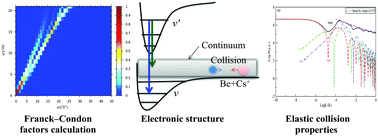Electronic structure, cold ion–atom elastic collision properties and possibility of laser cooling of BeCs+ molecular ion†
Abstract
The BeCs+ system represents a possible future candidate for the realization of samples of cold or ultra-cold molecular ion species that have not yet been investigated experimentally or theoretically. With the aim of highlighting the spectroscopic and electronic structure of the cesium and beryllium cation BeCs+, we theoretically investigate ground and low lying excited states of 1,3Σ+, 1,3Π and 1,3Δ symmetries below the first nine asymptotic limits dissociating into Be+(2s) + Cs(6s, 6p, 5d) and Be(2s2, 2s2p, 2s3s, 2p2) + Cs+. We used a quantum chemistry approach based on a semi-empirical pseudo potential for Be2+ and Cs+ cores, core polarization potentials (CPP), large Gaussian basis sets and full configuration interaction (FCI) method for the valence electrons. Additional calculations have been performed for the ground state using CCSD(T)/CI methods with different basis sets. Adiabatic potential energy curves, spectroscopic constants, vibrational levels, and permanent and transition dipole moments are reported in this work. Furthermore, the elastic scattering properties at low energy for both ground 11Σ+ and second excited states 31Σ+, of BeCs+ are theoretically investigated, and isotopic effects on cold and ultra-cold energy collisions are also detected. Vibrational lifetimes of the ground state 11Σ+ are calculated taking into account both spontaneous and stimulated emissions and also the absorption induced by black body radiation at room temperature (T = 300 K). Vibrational radiative lifetimes for the first 21Σ+ and second 31Σ+ excited states are also calculated and extensively analyzed. We found that the radiative lifetimes of the lower vibrational levels of the 11Σ+ state have an order of magnitude of seconds (s), while those of 21Σ+ and 31Σ+ states have an order of nanoseconds (ns). The Franck–Condon factors are also calculated for transitions from the low lying excited 21Σ+, 31Σ+, 11Π states to the ground state 11Σ+. We found that the favourite vibrational transition to the 11Σ+(v = 0) ground state is obtained for 11Π (v′′′ = 0)–11Σ+(v = 0) with a diagonal structure and a large Franck–Condon factor value of 0.94. This Franck–Condon factor value is sufficiently large to make the BeCs+ system a favorable candidate for direct laser cooling.

- This article is part of the themed collections: Ions, electrons, coincidences and dynamics: Festschrift for John H.D. Eland and 2022 PCCP HOT Articles


 Please wait while we load your content...
Please wait while we load your content...